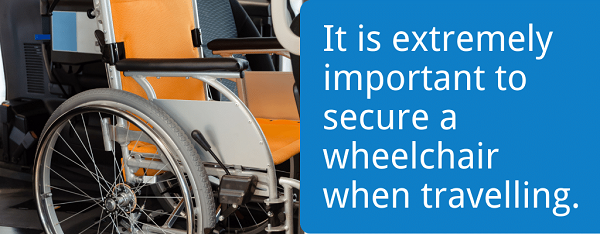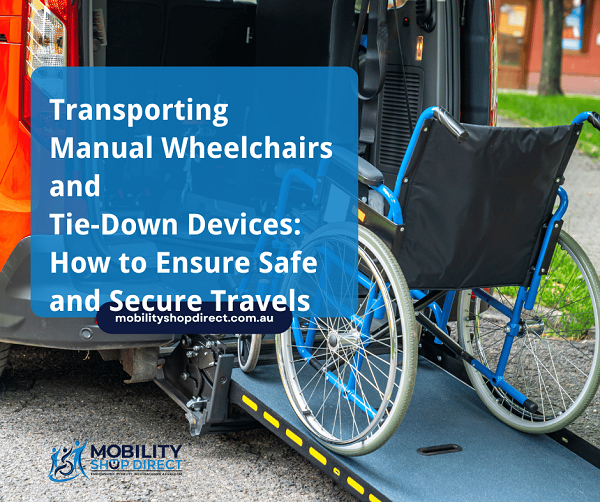When choosing a wheelchair, the focus can often fall on fit, mobility, durability and comfort. One factor commonly overlooked is safe transportation, which is important to protect yourself and others traveling with you from injury.
Whether it’s a trip to the doctor’s office, a long journey across the country, or even a day at the mall, you should be able to safely use and transport your wheelchair with ease and comfort.
Today, we’ll look at the different ways to ensure safe and secure travels when transporting manual wheelchairs and tie-down devices, as well as:
- Public and private transportation services
- Different types of tie-down devices for security
- The best practices for manual wheelchair transportation
Table of Contents
- Types of Transportation
- Tie-Down Devices
- Best Practices for Transportation
- About Mobility Shop Direct
1: Types of Transportation

The Australian Disability Standards for Accessible Public Transport (2002) and the Commonwealth Government’s Disability Discrimination Act (1992) state that people with disabilities are entitled to the same services as other Australian citizens.
As a manual wheelchair user, several transportation options are available for you, including public, private and special transportation services.
Public Transportation Services
Public transport includes buses, trams, trains and aeroplanes. Most of these transportation services have initiatives in place, making it easy for people with disabilities to access and use them.
Nearly all public buses in Australia have ramps to aid wheelchair users. With a disability, you can even travel for free in some cities, like Perth on Transperth bus routes.
For bus services in Melbourne and regional Victoria, you can find more information on the Public Transport Victoria website.
Melbourne also has a network of low-floor and high-floor trams. The latter are unsuitable for wheelchair users. However, you can easily access low-floor trams at access stops. Additionally, all Melbourne streetcars have priority seating near the driver for people with disabilities.
When it comes to trains, all V/Line trains and train stations offer accessibility for wheelchair users. Train conductors will help you board by placing a ramp between the carriage and the platform.
You can find out which V/Line regional services are accessible by calling them at 1800 800 007.
Australian airlines need at least three days notice when you intend to fly with them. This makes for easy planning when traveling by air.
Examples of airlines with wheelchair services include:
- Qantas
- Jetstar
- Rex
- Virgin Australia
The table below summarises Australian airlines and some of their wheelchair accessibility features.
| Airline | Airline Boarding, Inflight And Deplaning Assistance | Wheelchair Travel Features/Arrangements |
| Qantas |
|
|
| Jetstar |
|
|
| Rex |
|
|
| Virgin Australia |
|
|
Private Transportation
Although public transportation offers wheelchair accessibility, it’s not always the most convenient. You also have the option of using private transportation such as a car, SUV or van, also referred to as non-emergency medical transportation (NEMT).
NEMT offers the following advantages:
- Convenience: You don’t have to depend on public transport schedules because you can get on-demand transportation when needed.
- Reliability: NEMT drivers are trained to serve medical patients, including wheelchair users.
- Accessibility: NEMT ensures you’ll always have room for your wheelchair, unlike with public transport, where a wheelchair spot is not always guaranteed.

2: Tie-Down Devices
Wheelchair tie-downs are devices used to secure a wheelchair to a vehicle during transportation. They’re also referred to as “wheelchair restraints” or “docking systems.” It’s extremely important to secure a wheelchair when traveling to any destination.
Should the vehicle suddenly break, or in the event of an accident, these tie-downs can help prevent the wheelchair from being thrown about. They also help secure the wheelchair from shaking and moving when going over rough terrain.
The general rule of thumb is that a wheelchair requires four tie-downs: two in the front and two in the back. Additionally, the wheelchair occupant needs to have a 3-point seatbelt.
There are three types of tie-down devices you can use to secure manual wheelchairs to vehicles. These include straps, belts and locking mechanisms.
Straps
Straps, which are non-retractable, are the most basic form of wheelchair restraints available. Before securing a wheelchair with straps, it must first be in the right position. Only then can you tighten and release the straps.
These restraints are best used when there is an attendant or carer to help secure the straps to the wheelchair and vehicle.
Because these straps are non-retractable, they can easily become tangled and get in the way. This is why retractable tie-downs are the better option.
Belts
Belts, which are retractable, are secured to the wheelchair and to the floor of the vehicle. Retractable restraints are easy to operate with one hand, and the self-tightening feature allows for a quick and efficient restraining process.
Because retractable straps self-tighten, you won’t have to worry about tangling or loose straps.
Locking/Docking Systems
The last type of tie-down device is a locking and docking system. This system is popular because of how easy it is to secure a wheelchair. It boosts independent living for wheelchair users since all you need to do is push the wheelchair into a predetermined position.
The system consists of a docking station secured to the bottom of the vehicle. A retaining plate is then fitted to the bottom of the wheelchair, which you then slide into the docking station. It locks automatically, and that’s it! Effortless and hassle-free security.
Automated locking systems save you the time and effort otherwise spent on tying down straps and belts. They’re even required for wheelchair users who drive since it allows for securing without assistance.
Maintaining Tie-Down Devices
Routine maintenance is important to ensure that all the straps, belts, and locking mechanisms are in perfect working condition. Maintaining tie-down devices takes a few minutes and costs very little.
Here are a few things you can do to maintain tie-down devices:
- Ensure there are four chair tie-downs and a belt set for user restraint.
- Check every component to ensure that all latches and buckles work properly.
- Ensure the straps or belts are not frayed or cut.
- Ensure the tie-downs are stored properly when not in use.
- For docking systems, ensure the tracks are free from dirt and debris.
- Lubricate parts with high-quality lubricant.
Expert Tip: All the tie-down components should come from the same manufacturer and the same equipment series. This helps with compatibility since the components are designed to work together.
3: Best Practices for Transportation

Every wheelchair user is entitled to the benefits and freedom of travel. To ensure you travel safely and comfortably, here are several practices to help smoothen the process.
Securing and Loading a Manual Wheelchair Onto a Vehicle
To load a manual wheelchair onto a vehicle, follow the steps below:
- Have your driver or attendant park the vehicle in a safe and relatively flat area. They should ensure there is enough room for the lift or ramp, and avoid uneven terrain, high-traffic areas and tight spaces for easier loading.
- They should then deploy the lift or ramp to prepare for boarding.
- Have them assist you onto the ramp. Your driver or carer should also ensure that both you and the wheelchair are stable and properly balanced, respectively.
Properly Securing the User in the Wheelchair During Transportation
In addition to securing the wheelchair to the vehicle, you must also secure yourself to the wheelchair or have someone assist you in doing so. Once safely inside, you must put on a safety belt.
Never rely on just shoulder and lap belts as these will not keep you safe in the event of a crash. Instead, you should invest in a 4-point harness that offers firm trunk control, improves posture and frees your shoulders for better independence.
About Mobility Shop Direct
Mobility Shop Direct is a mobility store founded in 2019 by David Thiu. We’re passionate about providing mobility aid and information to help you maintain your independence.
We provide high-quality wheelchairs and wheelchair accessories at unbeatable prices. Our products are user-friendly and easy to use.
“Very good wheelchair. Easy to use, very light and easy to fold. An excellent product. Highly recommended.”
- Amalia H
We also offer fast (excluding weekends and public holidays) and free shipping to Metro and Inner Regional Suburbs of Australia.
“The ordering process was simple and the chair arrived within 2 days. The quality is fantastic …. ”
- Lynette P.
Not quite sure about the kind of wheelchair you want to purchase? We’re ready to help. Fill in this form and we’ll get in touch with the best recommendations.
Share on Facebook:




